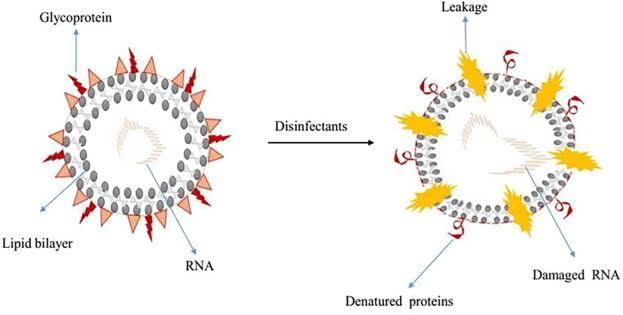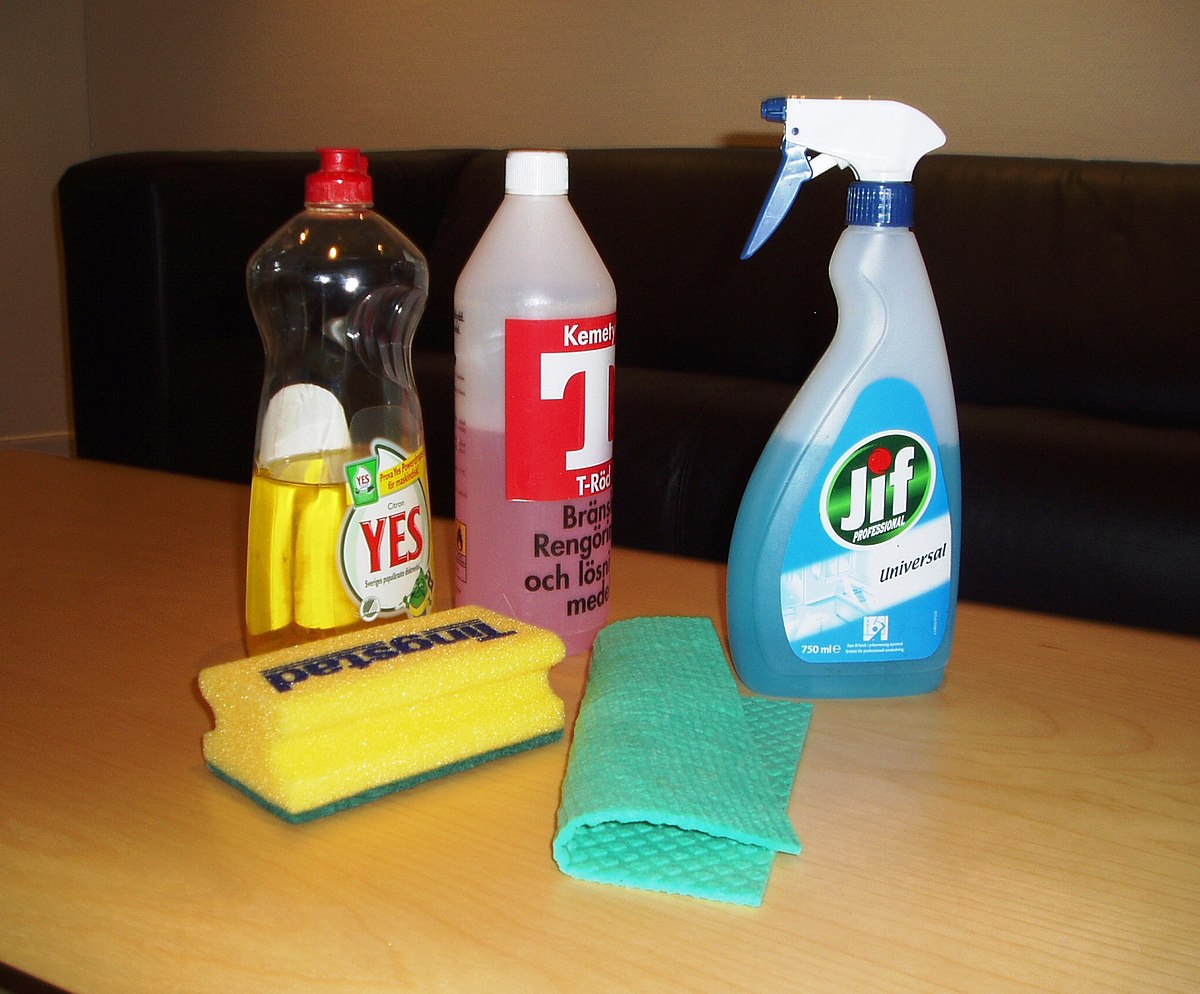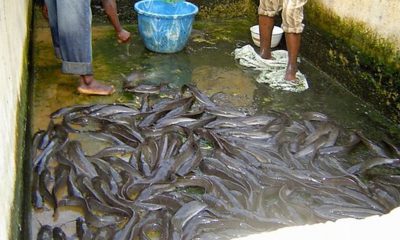Food Security
MICROBICIDE EFFECT OF VARIOUS DISINFECTANTS AND RELEVANT TOXICITY ON FOOD .

■ Understanding the effects of disinfectants and threats to global health .
■ SOME DISINFECTANTS:
• IODOPHORS, •HALOGENATED HYDROCARBON ACIDS, •PERACETIC ACID, •QUATERNARY AMMONIUM COMPOUNDS AND AMPHOTENSIDES, •BIGUANIDES •FORMALDEHYDE.
……@WufasAgronet, we are Food Security (food processing) Advocates.
✅Earned ‘FAO’ Top Fan Barge.
✅Member NAAJ, PAAJ, IFAJ & AFAN.
✅Consultancy services in Human Capital & Value Chain Development.
↔️WufasAgronet was a •Brew Master, •Bottler 7up plc, •Tech.Sales mgr Cadbury Nig. Plc., •Plant mgr Prime Distillery • CEO Wufason Food. ( Beverage & Dairy ).
DISINFECTANTS.
STUDY shows that the use of the ultraviolet rays (UV) and radioactive radiation for germ reduction in food is prohibited in the Federal Republic of Germany. Heat sterilisation may cause a deterioration in the quality of the product. However, Chemical disinfection standout as the only alternative available.
METHODS OF STERILISATION.
Years back, the discussion on toxicity of disinfectants has gained new impetus after traces of monobromoacetic acid were detected in 50% of all beers examined. To guarantee the minimum shelf life of food , it’s vital to reduce harmful microorganisms as far as possible or to products free of spoilage organisms. This can be achieved basically with the help of physical and chemical processes. As a general principle , high-energy ultraviolet and radioactive rays must be avoided in food products. Thermal energy (heat sterilisation ) , like the aforementioned rays might cause substantial changes in food. All these processes may lead to the formation of a great number of bye-products from natural ingredients of food, with no reliable data on their toxicity. Thus chemical disinfection is the only remaining alternative for destroying spoilage organisms.
TOXICOLOGICAL ASSESSMENT
Toxicologically , products differ by several orders of magnitude viz: some manufacturers sell highly toxic mixtures while others make major efforts to supply biologically degradable products with a reduced toxicity. In recent times , highly effective products became available to the food processing industry, complying with stringent Swiss Toxic Substances Law, American and European laws.
BIOACCUMULATION FACTOR
Things become somewhat more complicated when long term effects are also taken into consideration. Human and animal organs maybe damaged in the long term by various ‘mechanisms’.
Repeated exposure to low concentration can lead to a sensibilisation (allergy). In addition if the human systems lacks suitable biological degradation mechanism , accumulation may occur in certain organs eg heavy metals in kidney and liver; halogenated hydrocarbons, DDT,dioxin in the fatty tissues.
The likelihood of this occurring can be estimated using the BIOACCUMULATION factor or BIOCONCENTRATION factor (BCF) which indicates the ratio of a chemical substances in test animal (fish,mussel )to the concentration in the ambient aqueous medium in the steady state.
CHRONIC TOXICITY
When disinfectants are used in such a sensitive area as the food processing sector, chronic toxicity of chemicals and mixtures has to be very carefully assessed. The “no observed efficient level” may be used for comparative purposes, this is the highest concentration or dose at which no toxic effect is observed in a group of test animals of one species. However, another different type of organ damage may occur if reagents not only damage protoplastic structures of animal (human) cells but also affect the cell nucleus. This may lead to changes such as:
□ Mutagenic ones = damaging the genetic constitution.
□ Tetratogenic ones = causing malfunctions.
□ Carcinogenic ones = causing cancer.
DISINFECTANTS IN FOOD PROCESSING.
In the food processing industry, only a limited number of raw materials are suitable for use as disinfectants. In practice , use is made of products or mixtures of acidic or neutral quaternary ammonium and amphoteric compounds, biguanides, chlorine, iodine, bromine as a compound of sulphuric and phosphoric acid, peracetic acid and hydrogen peroxide, formaldehyde and aldehydic substances.
As chloride or chloride containing substances are used practically exclusively in the bottle washer.
IODOPHORS
The use of IODOPHORS years back en vogue , is at present decreasing drastically due to the formation of deposits on parts of the plant, causing massive disruption. Diffusion of the IODOPHORS in the tank lining and resulting danger of IODOPHENOL formation was another major drawback. In addition, some incidences of over sensitivity ( allergy )were observed in some staff members.
HALOGENATED HYDROCARBON ACIDS.
The halo acids, particularly monochloro and monobromoacetic acid are mostly used in practice. They allow extremely long storage periods and are reasonably priced.Although partly ignored is the fact that an adaptation occurs gradually in yeast and lactic acid bacteria and that some strains become increasingly more resistant.
As the said compounds are extremely toxic great care is necessary to ensure that sufficiently long rinsing periods are observed to guarantee that no traces of the substances are allowed into the beverage.
PERACETIC ACID.
This may be seen as a value for money alternative. It has very good microbicide properties and is also suitable for difficult to destroy sporiferious agents. It’s highly water soluble and can be rinsed off easily. When decomposition sets in, no Toxicologically objectionable substances are formed. However, these definite advantages are regrettably offset by a number of serious disadvantages.
• Its good microbicide properties can only be guaranteed when a predetermined active concentration is achieved, factors of a most divergent nature such as temperature, pH value and the catalytic influence of heavy metals can inactive the product. It is often overlooked that peroxides can participate in extremely dangerous and partly explosive reactions with a great many substances — eg. Acetone, ethanol, formic acid, acetaldehyde, glycerin, metal ions, caustic soda etc .
□ Furthermore , peroxides attack the skin and reach down to the subcutaneous fatty tissues, causing necroses which are difficult to heal. A number of organic derivatives tested in -vitro situations showed mutagenic effects. They have also caused tumours in some animal experiments.
QUATERNARY AMMONIUM COMPOUNDS AND AMPHOTENSIDES
Both of the above are grouped together as they have similar spectrum of activity. They have in part very good disinfectant properties and are in reduce toxicity category but have the serious disadvantage – adhering tightly to the surface and very difficult to remove, even with extensive rinsing. Therefore it has to be assumed in principle that food/drinks comes in contact with these additives. The Ames test revealed no mutagenic properties.
BIGUANIDES
These are member of the group of surfactants and have been used for disinfection of the mucous membranes for years. However, in practice , these substances also tend to form deposit ; the bacteriological spectrum of activity is extremely narrow.biguanides are often used in combination with strong acids.
FORMALDEHYDE.
Formaldehyde is a gas with good water solubility , This is a disinfectant which is universally applicable. It’s uses has a broad spectrum of activities against includes skin and mucuous membranes disinfectants eg. In gargling solution as well as commercially for space and area disinfection. It has a broad spectrum of activities against bacteria, mycobacteria, fungi, virus and bacteria spores. Its effectiveness is hardly influence by protein and similar substances and it is largely pH independent.
• Recently, increasing number of uses at home and abroad have reverted to formaldehyde as very satisfactory disinfection can be achieved with 1-2% solutions.
• In January 1986, World Health Organisation ( WHO ) decided that formaldehyde be removed from the list of substances suspected as being Carcinogenous.
For a number of years , mixtures of formaldehyde, glyoxal and glutaric dialdehyde have been used in disinfectants in the field of human medicine.
……to be continued.
At WufasAgronet, we are Competent and Reliable Food Technologists into Human Capital and Value Chain Consultancy services. Training the teeming youthful population especially graduates of tertiary institutions Ethics of food processing eg. Watertreatment, preservation, QC concept etc , Practical demonstrations of various classes of food and introduction to unit operations eg Heat applications- pasteurisation, filtration, centrifugation,milling, distillation, drying, extractions, mixing, etc.
Contact us: email. Wufasagronet@gmail.com
Food Security
CHARACTERISTICS OF GOOD DETERGENT

CHARACTERISTICS OF GOOD DETERGENT
www.wufasagronet.com
….. @WufasAgronet, we are Food Security (processing) Advocates.
✅Earned FAO, WFP, WORLD BANK, IFAD, IDA, IMF, UNSDGs, USAID, ROCKEFELLER FOUNDATIONS, BBC NEWS, JAGABAN ARMY, PUNCH NEWSPAPERS, GUARDIAN Newspapers, Today Reporters, Ripples News etc TopFan Barges.
✅Member NAAJ, PAAJ, IFAJ AND AFAN.
✅Consultancy Services in Human Capital and Value Chain Development in Food Processing technology.
DETERGENTS used for washing in industries should have the following characteristics.
-Ability to loosen organic matters eg. Soil etc. (organic dissolving power)
-Good rinsing power.
-Adequate wetting power to allow detergent to penetrate the deposit acting quickly and efficiently.
-Good sequestering power – removal of mineral deposits eg. Calcium, magnesium.
-Emulsifying power – fragmenting oil into tiny particles.
-Adequate germicidal power to sterilized dirty detergent solutions.
-Ability to dissolve alkali solutions precipitate of calcium and magnesium salt.
-It should not be corrosive.
-It should posses good buffering and saponifying powers.
The above characters may not be contained in a single detergent but if blended with others rich in some of the characters, a good result may be achieved.
MAJOR SOURCES OF DETERGENTS.
{Alkalis} – Caustic soda is the basic ingredient of detergent however,
there could be addition of other additives to give a property to the detergent. Other basic ingredients are Soda ash, Sodium silicate and others as seen above.
SEQUESTERING AGENT.
This is the action of polyphosphate in precipitation of calcium and magnesium salts in water creating additional wetting agent and polyphosphate to assist sequestration this would constitute most effective and economical clean-in-place detergent for brewing cleanings.
WETTING AGENT.
Known generally as synthetic detergent, Wetting agents are classified into 3 major types :An-ionic and Cat-ionic wetting agents.
The An-ionc type is commonly used for detergent formulation eg. Sulphated alcohols alkyl or aryl sulphonates. Non-ionic are mostly the polyethylonic oxide. On blending of both an ionic and catonic the result may be excessive foaming. It also processes good wetting, dispersing and rinsing power.
STERILISING AGENT.
Alkalis porcess sterilizing power, which increases with pH and temperature.
At WufasAgronet, we are competent and reliable Food Technologists into Human Capital and Value Chain Development Consultancy in Food Processing. Contact us email :wufasagronet@gmail.comPls go through the earlier sent documents.
Food Security
SEASONINGS. FLAVORS. FOOD INGREDIENTS.

✔Contact us @WufasAgronet for wide range of integrated flavors and seasonings, we are Manufacturers’ Representative.
…. @WufasAgronet we are Food Security (Processing) Advocates.
✅Earned FAO, WFP, WORLD BANK Group, UNSDGS, ROCKEFELLER FOUNDATIONS, BBC NEWS, JAGABAN ARMY, PUNCH NEWSPAPERS, GUARDIAN Newspapers, Today Reporters, Ripples News, etc TopFan Barges.
✅Member NAAJ, PAAJ, IFAJ & AFAN.
✅CONSULTANCY SERVICES IN HUMAN CAPITAL AND VALUE CHAIN DEVELOPMENT IN FOOD PROCESSING.
✔FLAVORS
BAKERY & PASTRY FLAVORS
*Vanilla flavor
*Condensed milk flavor
*Butter scotch flavor
*Enzyme chocolate flavor
*Enzyme butter flour
*Milk flavor
*Coconut flavor
✔ CONFECTIONERY & CANDY FLAVORS
*Strawberry flavor
*Chocolate flavor
*Orange flavor
*Butter vanilla flavor
*Banana flavor
*Mango flavor
*Lemon flavor
*Milk flavor
*Vanilla flavor
*Apple flavor
*Mixed berry flavor
*Coconut flavor
*Caramel flavor
*Honeydew flavor
*Condensed milk flavor
*Peanut flavor
*Cheese flavor
✔BEVERAGE FLAVORS
*Apple flavor
*Coconut flavor
*Caramel flavor
*Mango flavor
*Lemon flavor
*Banana flavor
*Pineapple Flavor
*Orange flavor *Strawberry flavor
*Natural Ginger flavor
*Malta flavor
*Grape flavor
*Raspberry flavor
✔ENCAPSULATED FLAVORS
*Strawberry flavor
*Raspberry flavor
*Mixed Berry flavor
*Orange flavor
*Apple flavor
*Banana flavor
✔BEVERAGES (CONCENTRATES, COMPOUNDS, BASES AND EMULSIONS) :
*Pineapple
*Lemon
*Ginger
*Cola
*Black currant
*Orange
*Strawberry
*Chapman
*Apple
*Banana
*Mixed fruit
*Cocopina
✔SAVOURY FLAVORS
*Beef flavor
*Chicken flavor
*Tomato flavor
*Cheese flavor
*Seafood flavor
*BBQ flavor
*Roasted flavor
*Smoked fish flavor
*Suya flavor
*Peanut flavor
*Roasted Chicken flavor
*Sardine flavor
*Smoke flavor
✔MILK POWDER :
*Fat filled milk powder
*Skimmed milk powder
*Full cream powder
*Flavored milk powder
*Butter milk powder
✔ICE-CREAM, YOGHURT & DAIRY FLAVORS :
*Yogurt flavor
*Vanilla flavor
*Strawberry flavor
*Banana flavor
*Mixed Berry flavor
*Chocolate flavor
*Cherry flavor
*Mango flavor
✔SEASONINGS:
FOOD SEASONINGS
*Beef seasoning
*Chicken seasoning
*Tomato seasoning
*Cheese seasoning
*BBQ Seasoning
*Seafood seasoning
*Noddles seasoning
*Pasta seasoning
*Jollof seasoning
✔SPICES :
*Cinnamon powder
*Onion powder
*Ginger powder
*Garlic powder
*Paprika powder
*Nutmeg powder
✔FOOD INGREDIENTS :
*Fat Replacer (Handisol – 25)
*Sweetener
✅OTHERS :
*Real meat reaction pastes
*Vegemeat for sausage roll
*Spice flavor oil
*Liquid and oil soluble flavor
*Soup and gravy mixes
*Ice cream premix
*BBQ sauce
*Tomato /Pizza sauce etc.
At WufasAgronet , we are competent and reliable Food Technologists into Human Capital and Value Chain Development Consultancy in Food Processing technology training the teeming youthful population including teirary institutions graduates in Global Competitiveness and International Best practices in Food Processing technology.
Contact email wufasagronet@gmail.com
Food Security
SECURITY PATHWAYS IN RELATION TO SUSTAINABLE FOOD SECURITY OF A NATION.

Good governance is predicated on ensuring the actualisation of the various security architecture of a Nation. The political barometer is also monitored through the efficiency of the security pathways which are :
INTERNAL SECURITY, INFORMATION/COMMUNICATION. , FOOD SECURITY, HEALTH ,EDUCATION, ELECTRICITY, TRANSPORTATION AND INDUSTRIAL GROWTH.
.
All the above are the essential security systems that can produce and provide QUALITY POPULATION through good and quality SUPERVISION
✅NATIONAL Security of life and properties is the (numero uno) number one responsibility of the Head of government be it President, Head of state and others. The mandate to secure life and property is paramount , they control and command the apparatus of security such as adequate Policing, effective Armed forces- Army for protection against external or internal aggression. Customs / Immigration for vigilant boarders patrol to prevent smuggling and immigration control amongst many others . Equipping them with weapons, Aircrafts, Vehicles, Boats etc.
For effective surveillance. In tackling the menace of bandits and kidnappers who have taken over the forest prohibiting farming activities . Armed Forest Guards / Rangers should be introduced.
INFORMATION/COMMUNICATION.
The entire world is in information age.
The constitution clearly stipulate that every person shall be entitled to freedom of expression, freedom to hold opinions and to receive as well as to impact ideas and information.
However, it is the opinion of this writer that freedom be guided with secured intent to prevent abuse that may result in conflicts and war through hateful and unguided utterances.
The most acceptable form of communication is such that promote humane, responsible and patriotic reportage upholding the concept of discipline and promoting values nationally and internationally.
A lot of opportunity mostly untapped abound for investment in Information and communication like Print, Electronic and ICT media.
For industrial growth, information through advertisement, publication and social media is vital for public awareness.
FOOD SECURITY
Whether one eat to live or live to eat is a matter of semantics the bottom – line is Food is the main sustainace of bodies and souls. The importance of food cannot be over emphasised . knowing this fact of life has made the developed world to appropriately plan for provision of quality food for their citizens. Provision of food is prioritize in their national agenda. It is on this note that the United Nation’s clarion call to others in the world to emulate the culture of Sustainable Food Security ensuring the Tripple A(s). of AVAILABILITY, ACCEPTABLITY and AFFORDABILITY. ( UN 2030 food security agenda) of good quality food for the underdeveloped countries who are import dependent on basic food items such as Rice, Sugar, Dairy , Beverages etc .
Presently, Nigeria is revolutionising agrioprenuerial activities, it’s hoped that the present policies on agriculture will not be Summersaulted. The Maputo declaration on allocation of minimum 10% of the country’s annual budget must go to agriculture. Food must be made a constitutional right for all. The authority must take time to support Micro and Small scale Agroprenuerails activities to adapt to climate change. Agroprenuerail activities is the surest way to lift hundreds of millions out of hunger, poverty, conflict and deaspiration.
HEALTH CARE
Health is wealth – Primary Health care delivery must be taken to the grassroot levels, while Rural Health care moblisation be made available and effective all must be well equipped with vaccines, drugs, consumables and other biologicals.
— Ensure maintenance of standard by private sector through effective monitoring.
— Tapping into Herbs Processing , local medical herbs be Researched into by National Institute of Pharmaceutical RnD. In Collaboration with Fed Mins. of Science and Technology.
— Integration of alternative medicine into health care.
— Health insurance scheme must be intensified on .
— Stemming of illegal importation of smuggled fake drugs and illegal drug manufacturing in the country.
EDUCATION
A Society, Community and Nation is as good as the percentage of her literary population. The various levels of education are Primary , Secondary and teriary education 6-3-3-4 .Education must attract appropriate budget at all time. Education is being administered by Public and Private participation at all levels. The special education must receive attention by provision of special equipment such as braille machine, audiometer etc.
ELECTRICITY
To the chagrin of the unsuspecting consumers and Contrary to claim of the generation companies that generation capacity has improved to 7000 MW , the actual has been fluctuating between 2500 -3500 MW.(April 2019)
The idea of mono grid must be jettison while the legislation be relaxed to accommodate Private participations in generation. While effort must be intensified on the Green Bond of #10.97bn raise in December 2018. for financing of SOLAR energy.
Industrial development is unachievable without steady supply of electricity. A green belt of
Industrial Parks on Green energy is recommended in all the States of federation.this will sustain industrial activities that will promote growth.
TRANSPORTATION
This sector is an indispensable catalyst for stimulating economic, social, political and strategic/defence development of a Nation. All the National Development plans must accord the transport sector very high priority. In the formulation of National Transport policy, there must be defined objectives such as economic efficiency and coordinated development plan.
All forms of transportation system are embraced in Nigeria. Motor ,Railway transportation, inland waterways, aviation terminal and handling facilities seaports, airports and riverports including other ancillary facilities.
The administration of Transportation is vested in both Fed. Ministry of Works and Housing (Fed. Highways – Interstate roads Construction and maintenance) and State Ministry of Works/Transport (interstate roads while LG is responsible for Urban and Rural roads Construction and maintenance.
Aviation Ministry for Civil Aviation, Airports Development Management and Metrological services.
Internationally, the railway system is more affordable and relatively saver the frequency in Nigeria must be upgraded not scanty show up as is now the case.
INDUSTRIAL GROWTH
The economic growth rate ( 2019) is 2.1% ,this development is not unconnected with the dismal performances of the various indices above. eg the manufacturing growth rate is presently less than 7% although the Fedreral government set a 10.6% goal in 2017.which was to be driven by SME. Productivity is the only stimulant for Industrial growth. Farming output is barely about 22% mostly subsistence. .about 55% of work force is absorbed by agriculture. The major farming communities in North East, Middle belt downwards to the southern section are being sacked either Boko Haram terrorist or Pasteuralist /Farmers conflicts and banditry.
The various activities as enumerated in this writeup are all depended on Food security system. FOOD SECURITY MUST BE IN THE FRONT BURNER TO ACHIEVE SUCCESS. IN OTHER SEGMENTS.
CONCLUSION
— FOOD Security issues must be in the front burner of government’s agenda. Since it encompasses all other activities.
— The effectiveness of other parasatal must be ensured through adequate supervision.
— TO PREVENT IMMINENT DANGER OF FAMINE. Forest Guards (armed) must be appropriately deployed to secure the large expanse of the forest for Farming activities.
— Indigenous Reserch and Development on local Technology be improved on.
— Electricity generation from Green Energy source should be encouraged in the Industrial parks.
— Food Security system must be made a CONSTITUTIONAL RIGHT for all the citizenry.
At WUFAS AGR0Net, we are Competent and Reliable Food Processing Technologists ,into Human Capital Development Consultancy. Centering on ETHICS of Food Processing Technology. Training on industrial food processing (General Manufacturing Principles ) to the teeming youthful population, startups and other Food handlers. We are seeking Collaboration and Strategic partnership with corporate bodies, NGOs and others
Interested in Food Security.
Contact: 08157784430, 08034064270.
Emails wufasagronet @gmail.com
-

 Environmental3 years ago
Environmental3 years agoOPINION: AN ACCESSMENT OF NIGERIA’S PERFORMANCE IN THE OPTICS OF THE UN 17 SUSTAINABLE DEVELOPMENT GOALS AGENDA 2030. ( Periodic quaterly review & update — ( September ’22)
-

 Food Security3 years ago
Food Security3 years agoREALITIES OF LARGE SCALE INTEGRATED AGROPRENUERAIL FARMING AND FOOD PROCESSING BUSINESS IN NIGERIA. (Update)
-

 Food Security4 years ago
Food Security4 years agoEXCITING FACTS ABOUT RANCHING
-

 Food Security3 years ago
Food Security3 years agoTOP SEVEN AGRICULTURAL COMMODITIES WITH HUGE UNTAPPED POTENTIALs – update
-

 Food Security4 years ago
Food Security4 years agoMITIGATING THE MENACE OF CLIMATE CHANGE THROUGH GREENBOND ISSUANCE.
-

 Food Security3 years ago
Food Security3 years agoFISH PROCESSING TECHNOLOGY
-

 Food Security4 years ago
Food Security4 years agoTHE ROLE OF E -COMMERCE IN SYNERGISING AGRICULTURAL VALUE CHAIN DEVELOPMENT IN AFCTA IS SINE QUA-NON.
-

 Food Security3 years ago
Food Security3 years agoTHE IMPENDING GLOBAL FAMINE FROM THE PERSPECTIVES OF THE WORLD INSTITUTIONAL LEADERS.
